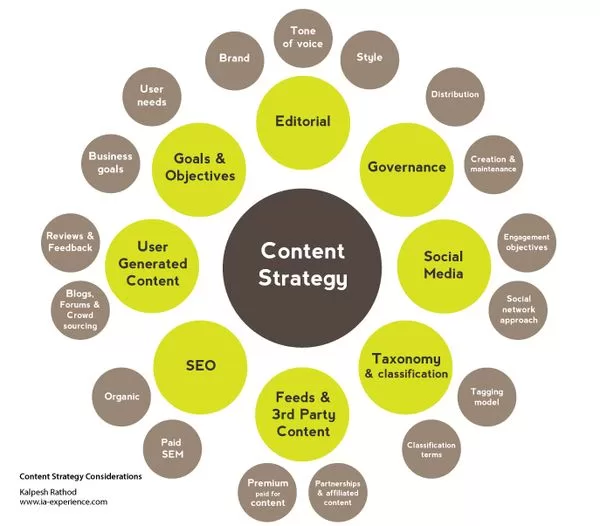A well-thought-through content strategy can be of great help in creating ‘pull’ for a brand. There are three critical points to note though. One, ‘content’, is a very generic term that encompasses a lot of things that sometimes have very little in common with each other. Two, content can be king, but without a strategy that aligns to business objectives, it is very difficult to sustain in the long-term. And three, content creation and marketing are different things, especially as social media is edging towards 0% organic reach!
The difference that a Fractional CMO makes is in the strategy and roadmap. Having done this for many brands that are known for their content (Myntra, Urban Ladder, Scripbox), here’s how I set about creating a content strategy.

Table of Contents
Toggle1. Why does the brand need a content strategy?
While creating ‘pull’ for the brand could definitely be a very broad objective, I prefer to frame it in a business funnel. i.e is it for demand generation, or lead generation, or conversion, or repeat business? The reason is a very pragmatic one. While it is easy to get early excitement from vanity metrics and anecdotal feedback, if there is no business impact, the effort will have a short shelf-life, even if it goes ‘viral’.
2. Who is it for?
Obviously, the brand’s target audience. But there are nuances. Is there a specific segment the brand wants to pursue for a winning entry? Let me explain with an example. Back in 2011, when e-commerce was just about getting started in India, my brief at Myntra was to ‘democratise fashion’. Remember that this was a time when people bought clothes only on special occasions.
We decided to focus on an audience that we knew would be interested in fashion, with a specific kind of content. That was how our most successful content was made – built around re-creating a star’s look in a ‘just-released’ Bollywood movie, with an ensemble collection from Myntra. As we started becoming the go-to place for this, we expanded into explanations of trends, Spring/Summer and Autumn/Winter collections and so on.
Understanding the audience – needs, interests, triggers, and barriers is extremely important for content to do its job. More on that in the next points.
3. What should the brand create?
Continuing from the last point, based on the consumer and competition, target the areas and segments where the brand can be relevant and add value. For instance, in 2015, though ecommerce was gaining ground, buying furniture online was still a new thing, and many people wondered about how it would all work.
At Urban Ladder, we created a property called #ULStories. Completely user generated content. In the beginning, it required a prompt from us, but later, it became organic because people loved to show off their homes. What did it do for the business? Many things. The display of UL furniture in a ‘home like ours’ does wonders to another person’s desire. It also showed that buying furniture online from UL was not that risky, and it was quite easy too.
And when we discovered that a lot of our customers had pets, we made this. 🙂
Between keyword planning and speaking to customers, it is not so difficult to create customer personas, and then craft targeted content that they want to consume.
However, arriving at versions of the brand voice, tonality and style that fits the platform, understanding whether an influencer works for the category, whether you need a webinar or a podcast for thought-leadership, should you attempt moment marketing with a trending topic, are all questions a content strategy has to answer.
4. Which platform should the brand focus on?
Back when investing online was still a new thing, keywords gave a clear idea about the kind of questions that customers wanted answers to. That’s how the Scripbox blog was started. This was before social platforms became universal. People did not mind reading long-form educational content when it came to money and investing. This not only created awareness, but did a great job with lead generation too. Later, as video consumption gained ground, we started doing explainer videos on YouTube. And then Shorts.
Myntra’s content play began on a blog, moved to Twitter and Facebook, and then, because the category was so visual in nature, Instagram and YouTube were an obvious destination. Ditto for UL whose first home was Facebook, but then Instagram too. However, the most successful component was the UL daily newsletter. Imagine the kind of content that would make people not just look forward to, and read a newsletter, but even reply?
Today notifications go viral, and WhatsApp groups are a great way to build community. Remember to understand the audience’s usage of media platforms, and the kind of format they prefer for consuming information in the specific category.
5. How does a brand go about production and promotion?
Creating an account on social media is the easiest thing to do, but having an editorial policy, defining content pillars, and a publishing calendar, evaluating tools, incl Gen AI, which can help in publishing, monitoring, responding, and measuring, and understanding what content to repurpose and how, making sure the team has a process for moment marketing- these are some of the things that take some planning and effort.
The era of produce and forget is long over. Content marketing is crucial in ensuring customers actually see the content, in their digital journeys. Finding internal, and customer champions who can help distribute it, exploring ways of seeding the content, maybe finding a budget that allows for some initial boost, are all things to think about.
6. (How) should we measure it?
As I mentioned earlier, once the initial charm of vanity metrics have disappeared, content production and promotion resources have to be seen as contributing to the overall business growth. When the content strategy has been built with business objectives in mind, mapping platform metrics to brand and business metrics from Reach and Share of Voice to CAC and LTV will start becoming possible. And that in turn, will help sustain the activity for a longer period, which is absolutely necessary for success.
As you’ve seen, under the broad umbrella of content is a dynamic set of components which need to function like well-oiled machinery. That is what a content strategy does, and getting it right will provide you an additional engine of brand and business growth. The Fractional CMO adds value by understanding the context of the business, consumer, and competition, and crafting a content strategy that meets brand and business objectives.
